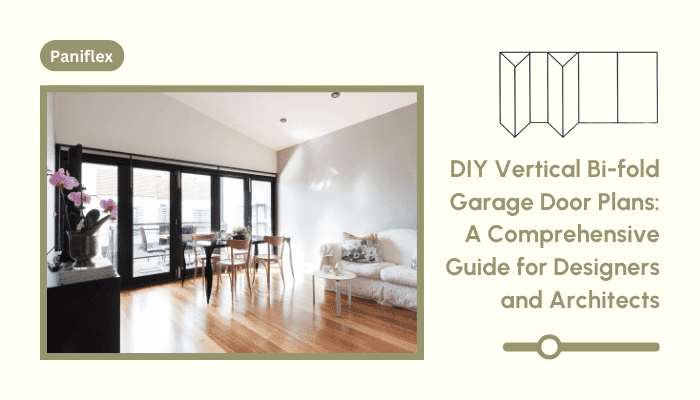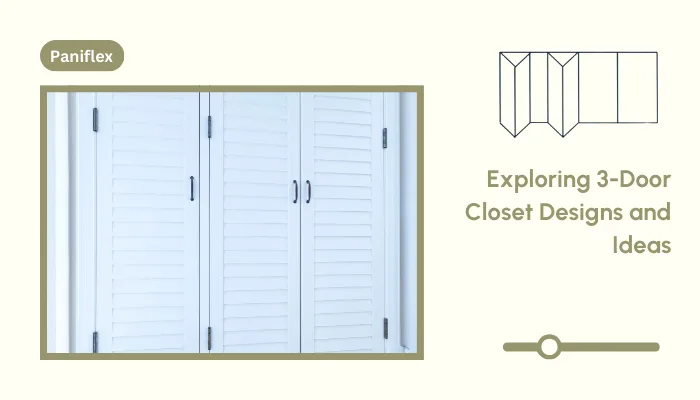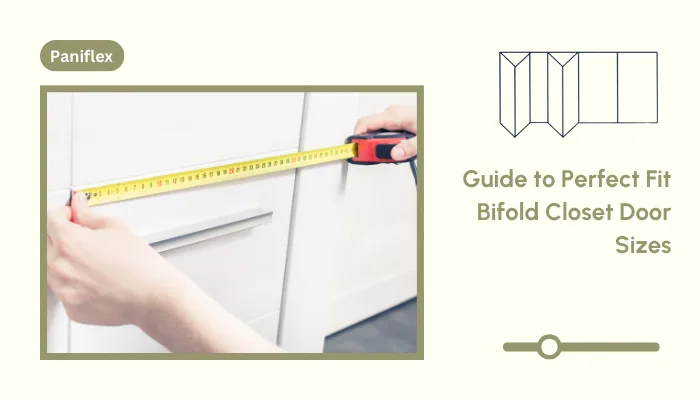As an interior designer or architect, you constantly seek innovative solutions that blend form and function. Enter the world of vertical bi-fold garage doors—a game-changer in aesthetics and practicality. Let’s explore why these doors are gaining popularity and how to incorporate them into your designs.
Also Read: Innovation In Architecture: Embracing Technology To Shape The Future Of Design
The Appeal of Vertical Bi-fold Garage Doors
Vertical bi-fold garage doors offer numerous advantages that make them an attractive option for modern homes and commercial spaces:
- Aesthetic Value: These doors provide a sleek, contemporary look that can significantly enhance a building’s facade. Their clean lines and modern appearance can transform an ordinary garage into a striking architectural feature.
Also Read: Modern Contemporary Cabinet Door Styles & Trends for 2024
- Space-Saving Benefits: Unlike traditional overhead doors requiring ceiling space, vertical bi-fold doors fold upward, maximizing interior and exterior space. This feature is precious in urban settings where space is premium.
- Customization Options: You can tailor these doors to complement various architectural styles, from ultra-modern to industrial chic. You can craft them from different materials, including wood, metal, or glass, allowing for endless design possibilities.
- Natural Light: Many designs incorporate glass panels, which allow natural light to flood the interior space, creating a brighter, more inviting atmosphere.
- Improved Ventilation: Some models allow for partial opening, providing better air circulation without fully exposing the interior.
Ready to experience the benefits of custom closet doors? Explore our range of Paniflex products now.
Benefits of Building and Installing Your Own Door
Taking on a DIY vertical bi-fold garage door project offers several advantages:
- Cost-Effectiveness: DIY installation can significantly reduce costs compared to professional installation, allowing you to allocate budget to higher-quality materials or other aspects of your project.
- Customization Control: By building the door yourself, you gain full control over materials, dimensions, and design elements. This level of customization ensures the door perfectly fits your vision or your client’s requirements.
- Skill Development: This project offers valuable hands-on experience in construction, mechanics, and problem-solving. You can apply these skills to future projects and enhance your professional capabilities.
- Client Impressions: Showcasing your ability to execute complex projects can impress potential clients and set you apart from competitors. It demonstrates your versatility and commitment to innovative solutions.
- Understanding Mechanics: Building the door yourself provides insight into its operation, making future maintenance and troubleshooting easier.
Also Read: Understanding Different Types of Doors and Windows in House Design
Vertical Bi-fold Garage Door Plans: An Essential Starting Point
Before diving into construction, acquiring detailed vertical bi-fold garage door plans is crucial. These plans serve as your roadmap to ensure precision and safety throughout the project. A comprehensive set of plans typically includes:
- Exact measurements and dimensions for all components
- Detailed material specifications
- Step-by-step assembly instructions
- Safety guidelines and precautions
- Wiring diagrams for motorized options
- Recommendations for tools and equipment
Investing time in studying and understanding these plans will save you time and potential headaches during construction.
Also Read: Common Door Materials and Their Purpose
Now that you’ve a solid grasp of the plans, let’s explore the details of designing these stunning doors.
Planning and Designing Vertical Bi-fold Garage Doors
Basic Principles of Vertical Bi-fold Garage Doors
To successfully implement your vertical bi-fold garage door plans, you must understand the fundamental principles behind their operation:
- Sectional Design: You’ll divide the door into two or more horizontal sections, typically of equal size. This segmentation allows for the folding action.
- Hinged Connections: Heavy-duty hinges connect these sections along their horizontal edges. The hinges must be robust enough to support the weight of the panels and withstand frequent use.
- Vertical Folding: When opened, the sections fold upward, stacking vertically. This action gives the door its space-saving properties.
- Track System: A track guides the door’s movement, ensuring smooth and consistent operation. You’ll usually mount the track on either side of the door opening and extend it vertically.
- Counterbalance: Springs or counterweights balance the door’s weight, making manual operation easier and reducing strain on motorized systems. This is crucial for safe and efficient operation.
- Sealing Mechanism: Weather stripping and seals between panels prevent drafts and moisture ingress when you close the door.
- Optional Motorization: While manual operation is possible, many designs incorporate motors for ease of use, especially for larger or heavier doors.
Detailed Schematic and Measurements
Your vertical bi-fold garage door plans should include comprehensive schematics and measurements. These typically cover:
- Overall Door Dimensions: Precise width, height, and depth measurements when the door is both open and closed.
- Panel Specifications: Detailed size and thickness of each panel, including any variations if using different materials for different sections.
- Frame Details: Exact dimensions and assembly instructions for the frame, including cross-sections showing how different components fit together.
- Hardware Placement: Precise locations for hinges, tracks, rollers, and other hardware. This should include measurements from reference points to ensure accurate installation.
- Folding Mechanism: Detailed diagrams showing how the door folds and operates, including the arc of movement and clearance requirements.
- Track System Layout: Specifications for track placement, including distance from walls and ceiling, and any support brackets needed.
- Counterbalance System: Diagrams showing the placement and configuration of springs or counterweights, including tension specifications.
- Wiring Diagrams: Detailed electrical schematics are needed for safe and correct installation if motorization is included.
- Seal and Weatherstripping Placement: Instructions for where and how to install weatherproofing elements.
Following these detailed plans ensures that all components fit together correctly and function as intended.
Are you ready to roll up your sleeves? Let’s gather everything you’ll need to make this project a reality.
Gathering Materials and Tools
Essential Materials for Construction
Selecting the suitable materials is crucial for the success of your vertical bi-fold garage door project. Here’s a closer look at what you’ll need:
- Door Panels:
- Choose based on climate, insulation needs, and aesthetic preferences.
- Options include wood (e.g., cedar or marine-grade plywood), metal (aluminum or steel), or composite materials.
- Consider factors like weight, durability, and maintenance requirements.
- Frame Materials:
- Typically steel or aluminum for durability and strength.
- Ensure the chosen material can support the weight of your panels.
- Hinges:
- Heavy-duty hinges designed specifically for the weight and size of your door.
- Look for corrosion-resistant options for longevity.
- Tracks:
- Must be precisely aligned for smooth operation.
- Choose tracks rated for the weight of your door.
- Rollers:
- Ensure they’re rated for your door’s weight.
- Consider nylon rollers for quieter operation.
- Cables and Springs:
- Critical for the counterbalance system.
- Select based on the door’s weight and dimensions.
- Weatherstripping:
- To seal gaps and improve energy efficiency.
- Choose durable, weather-resistant materials.
- Insulation:
- If needed for climate control.
- Options include foam boards, spray foam, or fiberglass batts.
- Fasteners:
- Various screws, bolts, and nuts as specified in your plans.
- Ensure they’re appropriate for the materials you’re using.
- Finish Materials:
- Paint, stain, or sealant suitable for your panel material.
- Primer if necessary.
Tools Required for the Build
Having the right tools on hand will make your construction process smoother and more efficient:
- Circular Saw:
- For cutting panels and frame materials.
- Ensure you have blades appropriate for the materials you’re cutting.
- Drill and Bits:
- For creating holes for hardware installation.
- Include a variety of drill bit sizes and types (e.g., wood, metal).
- Measuring Tape and Level:
- Crucial for precise measurements and alignments.
- A laser level can be particularly helpful for track installation.
- Screwdrivers and Wrenches:
- For fastening hardware.
- Include both manual and power options if possible.
- Hammer and Chisel:
- For minor adjustments and fitting.
- Laser Level:
- Helpful for ensuring perfect alignment of tracks and frame.
- Clamps:
- To hold pieces in place during assembly and installation.
- Sawhorses:
- For supporting materials during cutting and assembly.
- Utility Knife:
- For cutting weatherstripping and other soft materials.
- Socket Set:
- For tightening bolts and nuts securely.
Also Read: Simple Steps to Install a Pre-Hung Interior Door
Safety Equipment and Precautions
Safety should be your top priority when working on vertical bi-fold garage door plans. Here’s what you need:
- Safety Goggles:
- Protect your eyes from debris during cutting and drilling.
- Dust Mask:
- Use when cutting materials, especially with treated wood or fiberglass insulation.
- Work Gloves:
- Protect your hands from splinters, sharp edges, and pinch points.
- Steel-Toed Boots:
- To protect your feet from falling materials.
- Ear Protection:
- Use when operating loud power tools.
- First Aid Kit:
- Keep one easily accessible in your work area.
- Fire Extinguisher:
- Have one on hand, especially if working with electrical components.
Remember these safety precautions:
- Ensure proper ventilation when working with paints, stains, or adhesives.
- Always have a partner when handling large panels or heavy components.
- Disconnect power sources when working on electrical components.
- Follow manufacturer guidelines for all tools and materials.
- Take regular breaks to avoid fatigue, which can lead to accidents.
By carefully selecting your materials, gathering the right tools, and prioritizing safety, you’ll be well-prepared to begin the construction phase of your vertical bi-fold garage door project.
Got everything ready? Great! Let’s get into the exciting part of actually building your door.
Constructing the Vertical Bi-fold Garage Doors
Cutting and Preparing the Panels
The first step in bringing your vertical bi-fold garage door plans to life is preparing the door panels:
- Measuring and Marking:
- Carefully measure and mark your panels according to your plans.
- Double-check all measurements before cutting.
- Use a straightedge to ensure your lines are perfectly straight.
- Cutting:
- Use a circular saw to cut panels to size.
- For cleaner cuts, use a fine-toothed blade appropriate for your material.
- If working with metal panels, use a metal-cutting blade or shears.
- Sanding and Finishing:
- Sand the edges to prevent splinters and improve the finish.
- For wood panels, start with coarse-grit sandpaper and progress to finer grits.
- Round off sharp corners slightly for safety.
- Sealing (for wood panels):
- Apply a sealant to protect against moisture and warping.
- Choose a sealant compatible with your chosen finish.
- Allow adequate drying time before proceeding.
- Cutting Openings (if applicable):
- If your design includes windows or vents, carefully cut these openings.
- Use a jigsaw for intricate cuts.
- Sand the edges of these openings thoroughly.
Assembly of the Frame
A sturdy frame is crucial for the proper functioning of your vertical bi-fold garage door:
- Layout:
- Lay out frame components according to your vertical bi-fold garage door plans.
- Use sawhorses or a flat surface to ensure proper alignment.
- Outer Frame Assembly:
- Begin with the outer frame, ensuring corners are square.
- Use a carpenter’s square to check for 90-degree angles.
- Secure corners with appropriate fasteners or welding if using metal.
- Adding Supports:
- Attach vertical and horizontal supports as specified in your plans.
- Ensure these are evenly spaced and securely fastened.
- Leveling:
- Use a level frequently to ensure the frame remains true.
- Adjust as necessary before finalizing connections.
- Reinforcement:
- Add any additional bracing or reinforcement specified in your plans.
- This is particularly important for larger doors or those in high-wind areas.
Also Read: How to Fix a Large Gap Under the Door?
Attaching Hinges and Hardware
Proper installation of hinges and hardware is essential for smooth operation:
- Marking Hinge Locations:
- Precisely mark hinge locations on both panels and frame.
- Use a template if provided in your vertical bi-fold garage door plans.
- Pre-drilling:
- Pre-drill holes for hinges to prevent splitting, especially in wood panels.
- Ensure drill bit size matches your fasteners.
- Hinge Attachment:
- Attach hinges securely, ensuring they allow smooth movement.
- Use lock washers or thread-locking compound for added security.
- Roller Installation:
- Install rollers at the top of each panel.
- Ensure they’re properly aligned with the tracks.
- Handle Attachment:
- Attach handles or pull-downs for manual operation.
- Position these at a comfortable height for easy use.
- Weather Stripping:
- Install weather stripping between panels and along edges.
- Ensure a tight seal when the door is closed.
With the frame and panels prepped, it’s time to bring it all together and see your vision start to take shape.
Installing the Vertical Bi-fold Garage Doors
Preparing the Garage Opening
Proper preparation of the garage opening is crucial for a successful installation:
- Cleaning:
- Thoroughly clean the area, removing any debris or old hardware.
- Ensure the surfaces are dry and free from grease or oil.
- Inspection:
- Check that the opening is level and plumb.
- Measure diagonals to ensure the opening is square.
- Header Installation:
- Install a header board above the opening if required.
- Ensure it’s level and securely fastened to structural supports.
- Floor Preparation:
- Verify the floor is level where the door will sit when closed.
- Address any unevenness that could affect door operation.
- Electrical Preparation:
- If motorizing the door, ensure power supply is available and properly installed.
Also Read: How to Install and Replace Closet Doors
Hanging the Doors
This step requires precision and often benefits from an extra set of hands:
- Track Installation:
- Install the track system according to your vertical bi-fold garage door plans.
- Use a level to ensure tracks are perfectly vertical.
- Securely fasten tracks to the wall and header.
- Door Lifting:
- Carefully lift the assembled door into place.
- This step usually requires at least two people.
- Use temporary supports to hold the door in position.
- Connecting to Tracks:
- Connect the top of the door to the track system.
- Ensure rollers are properly seated in the tracks.
- Counterbalance System:
- Attach the counterbalance system (springs or cables).
- Follow manufacturer instructions carefully, as these systems can be dangerous if improperly installed.
- Initial Testing:
- Slowly test the door’s movement to ensure smooth operation.
- Make any necessary adjustments before proceeding.
Adjusting and Aligning
Fine-tuning is essential for optimal performance:
- Operational Test:
- Test the door’s operation slowly, observing for any binding or sticking.
- Listen for unusual noises that might indicate misalignment.
- Track Alignment:
- Adjust the track alignment if the door binds or sticks at any point.
- Ensure tracks remain parallel and properly spaced.
- Counterbalance Adjustment:
- Fine-tune the counterbalance system for smooth opening and closing.
- The door should stay in place when stopped at any point in its travel.
- Seal Verification:
- Check that the door closes evenly and seals properly when shut.
- Adjust weather stripping as needed for a tight seal.
- Hardware Tightening:
- Double-check all hardware and tighten any loose connections.
- Ensure hinges are functioning smoothly without excessive play.
Also Read: Guide To Sizing A Rough Opening For Bifold Doors
Alright, the main assembly is done! Let’s add those finishing touches to make your door stand out.
Finishing Touches
Painting or Staining the Doors
The final appearance of your vertical bi-fold garage door is crucial:
- Surface Preparation:
- Clean the door thoroughly to remove any dirt or oil.
- Sand any rough spots for a smooth finish.
- Finish Selection:
- Choose a finish that complements the home’s exterior.
- Consider durability and maintenance requirements in your choice.
- Priming:
- If painting, use a primer suitable for the door material.
- Allow the primer to dry completely before painting.
- Application:
- Apply paint or stain evenly, following the grain if using wood.
- Use long, smooth strokes for a professional look.
- Apply multiple thin coats rather than one thick coat for better durability.
- UV Protection:
- Consider a UV-resistant finish for added durability, especially for doors exposed to direct sunlight.
Also Read: Step-by-Step Guide to Door Painting – Tips and Methods
Adding Insulation if Necessary
Insulation can significantly improve energy efficiency:
- Measurement:
- Measure the interior of each panel carefully.
- Account for any obstructions or hardware.
- Cutting Insulation:
- Cut insulation to fit snugly within each section.
- Use a sharp utility knife for clean cuts.
- Installation:
- Secure insulation with adhesive or mechanical fasteners.
- Ensure a tight fit without compressing the insulation excessively.
- Sealing:
- Seal any gaps to maximize energy efficiency.
- Use foam sealant for small gaps around the edges.
Weatherproofing and Sealing
Proper sealing is crucial for energy efficiency and longevity:
- Bottom Seal:
- Install weatherstripping along the bottom of the door.
- Choose a flexible material that can conform to slight floor irregularities.
- Panel Seals:
- Add seals between panels to prevent drafts.
- Ensure these don’t interfere with the door’s folding action.
- Frame Sealing:
- Caulk around the door frame to seal any gaps.
- Use a weatherproof, paintable caulk for best results.
- Drip Edge:
- Consider adding a drip edge at the top of the door for added protection against water infiltration.
Following these detailed steps, you’ll create a functional, efficient, and attractive vertical bi-fold garage door showcasing your design and construction skills.
Before we wrap up, let’s review some tips for keeping your masterpiece in top shape for years to come.
Maintenance and Troubleshooting
Regular Maintenance Tips
To ensure the longevity and smooth operation of your vertical bi-fold garage door, follow these maintenance tips:
- Lubrication:
- Lubricate moving parts (hinges, rollers) every 6 months.
- Use a silicone-based lubricant for metal parts.
- Apply sparingly to avoid attracting dust and debris.
- Cable and Spring Inspection:
- Inspect cables and springs for wear annually.
- Look for fraying, rust, or signs of excessive stretching.
- If you notice any issues, consult a professional for replacement.
- Track Cleaning:
- Clean tracks to prevent debris buildup.
- Use a brush or vacuum to remove dirt and grime.
- Wipe down with a damp cloth, then dry thoroughly.
- Hardware Check:
- Tighten any loose hardware.
- Check for signs of wear or corrosion on bolts and screws.
- Replace any damaged or severely corroded hardware.
- Weather Seal Inspection:
- Check weather seals for cracks or brittleness.
- Ensure they maintain a good seal when the door is closed.
- Replace if they show signs of deterioration.
- Balance Test:
- Perform a balance test by disconnecting the opener and manually lifting the door halfway.
- It should stay in place without rising or falling.
- If it doesn’t, adjust the spring tension or consult a professional.
- Paint Touch-ups:
- Touch up any chips or scratches in the paint to prevent rust.
- Use paint that matches the original finish.
Common Issues and Fixes
Even with regular maintenance, you may need some help. Here are common problems and their solutions:
- Door Sticking:
- Check track alignment and ensure it’s clear of debris.
- Lubricate moving parts.
- Inspect rollers for damage and replace if necessary.
- Uneven Closing:
- Adjust the counterbalance system.
- Check for loose hinges or brackets and tighten as needed.
- Ensure the tracks are level and properly aligned.
- Noisy Operation:
- Lubricate moving parts.
- Tighten loose hardware.
- Check for worn rollers or hinges and replace as needed.
- Weather Seal Failure:
- Replace weatherstripping as needed.
- Ensure the door is properly aligned in the frame.
- Check for any obstructions preventing a tight seal.
- Door Reversing When Closing:
- Clean and adjust the safety sensors.
- Check for objects obstructing the door’s path.
- Verify that the close force setting isn’t too sensitive.
- Opener Malfunction:
- Check the power source and connections.
- Ensure the remote control batteries are fresh.
- Consult the opener manual for specific troubleshooting steps.
Ensuring Long-term Durability
To maximize the lifespan of your vertical bi-fold garage door, consider these long-term maintenance strategies:
- Regular Repainting:
- Repaint or reseal the door every 2-3 years.
- This protects the material and maintains appearance.
- Prompt Repairs:
- Replace worn parts promptly to prevent further damage.
- Address small issues before they become major problems.
- Professional Servicing:
- Consider annual professional servicing for complex issues.
- This is especially important for motorized systems.
- Area Maintenance:
- Keep the area around the door clear to prevent damage.
- Trim any nearby vegetation that could interfere with operation.
- Seasonal Adjustments:
- Make minor adjustments seasonally to account for temperature changes.
- This is particularly important in climates with extreme temperature variations.
- Documentation:
- Keep a maintenance log to track servicing and repairs.
- This can help identify recurring issues and predict future maintenance needs.
- Upgrade Considerations:
- Periodically assess whether upgrades could improve efficiency or security.
- Consider adding smart home integration for improved functionality.
Ready to experience the benefits of custom closet doors? Explore our range of Paniflex products now.
Conclusion
Embarking on a DIY vertical bi-fold garage door project is challenging but rewarding. By following these comprehensive plans, you’ve not only created a unique and functional feature for your space but also enhanced your skills as a designer or architect.
Remember, the key to success lies in careful planning, precise execution, and ongoing maintenance. Your attention to detail throughout this process will result in a door that operates smoothly and adds significant value and aesthetic appeal to the property.
As you complete this project, consider how you can leverage this experience in future designs. The knowledge gained about materials, mechanics, and custom solutions can inform innovative approaches to other architectural challenges.
Remember that companies like Paniflex offer a range of customizable door options for those seeking further inspiration or specialized components. Their expertise in bifold designs can complement your DIY efforts or provide solutions for more complex projects.






